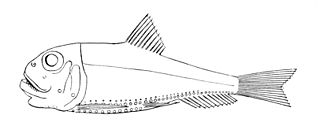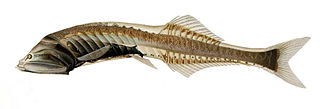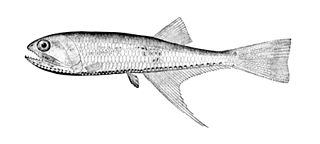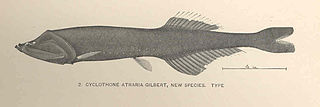
Minnow is the common name for a number of species of small freshwater fish, belonging to several genera of the families Cyprinidae and Leuciscidae. They are also known in Ireland as pinkeens.

The Gonostomatidae are a family of mesopelagic marine fish, commonly named bristlemouths, lightfishes, or anglemouths. It is a relatively small family, containing only eight known genera and 32 species. However, bristlemouths make up for their lack of diversity with relative abundance, numbering in the hundreds of trillions to quadrillions. The genus Cyclothone is thought to be one of the most abundant vertebrate genera in the world.

Lightfishes are small stomiiform fishes in the family Phosichthyidae

The veiled anglemouth, Cyclothone microdon, is a bristlemouth of the family Gonostomatidae, abundant in all the world's oceans at depths of 300 – 2,500 meters. Its length is 10–15 cm (4–8 in) though the largest known specimen is 7.6 cm (3 in). It gets its name from its circular mouth, filled with small teeth: the name “cyclothone” means in a circle or around and “microdon” means small teeth. The International Union for Conservation of Nature (IUCN) has assessed the veiled anglemouth is of Least Concern due to its abundance in most oceans and the little effect human impact has on its population growth. Some of the veiled anglemouth's physical features include a brown to black body with a radiating, or expansive, bioluminescent pigment over its head and fins.

Cyclothone is a genus containing 13 extant species of bioluminescent fish, commonly known as 'bristlemouths' or 'bristlefishes' due to their shared characteristic of sharp, bristle-like teeth. These fishes typically grow to around 1-3 inches, though some can be larger. They are most commonly found in the mesopelagic zone of the ocean, mostly at depths of over 300 meters, and many species have bioluminescence.

Bonapartia pedaliota, the longray fangjaw, is a species of bristlemouth found in the Atlantic and Indian Oceans. It is the only described species in its genus. This species grows to a length of 7.2 centimetres (2.8 in) SL.

Gonostoma is a genus of bristlemouths.
Peckoltia multispinis, commonly known as the bristlemouth catfish, is a species of small freshwater fish in the genus Peckoltia of the catfish family Loricariidae. It has the L-number L049. It is possibly a junior synonym for Peckoltia vittata. However, the online Encyclopedia of Life lists this fish as Lasiancistrus multispinis. The California Academy of Sciences lists Peckoltia multispinis as the currently correct name. This species is not to be confused with the valid but unrelated species Ancistrus multispinis, and although A. multispinis has been used as a name for both this species and the one it is currently used for, A. multispinis was initially described as a member of the now-invalid genus Xenocara and was classified under that genus when this species was first described as a member of Ancistrus. Because of this, Ancistrus multispinis is a valid name, but not one that should be used for P. multispinis.
Cyclothone alba, commonly known as the bristlemouth, is a species of ray-finned fish in the genus Cyclothone. It is found across the world, in the Pacific, Indian, and Atlantic Oceans.

Cyclothone atraria, commonly known as the deep-water bristlemouth, is a species of ray-finned fish in the genus Cyclothone. It is found in the North Pacific.
Cyclothone braueri, commonly known as the garrick, is a species of ray-finned fish in the genus Cyclothone.
Cyclothone kobayashii, commonly known as the Kobayashi's bristlemouth, is a species of ray-finned fish in the genus Cyclothone. It is found in the Southern Ocean.
Cyclothone livida is a species of ray-finned fish in the genus Cyclothone. It is found in the Eastern Atlantic Ocean.
Cyclothone obscura, commonly known as the hidden bristlemouth, is a species of ray-finned fish in the genus Cyclothone.
Cyclothone pallida, commonly known as the tan bristlemouth, is a species of ray-finned fish in the genus Cyclothone.
Cyclothone pallida, commonly known as the shadow bristlemouth, is a species of ray-finned fish in the genus Cyclothone.
Cyclothone pseudopallida, commonly known as the slender bristlemouth, is a species of ray-finned fish in the genus Cyclothone.
Cyclothone signata, the showy bristlemouth, is a species of ray-finned fish in the genus Cyclothone.






